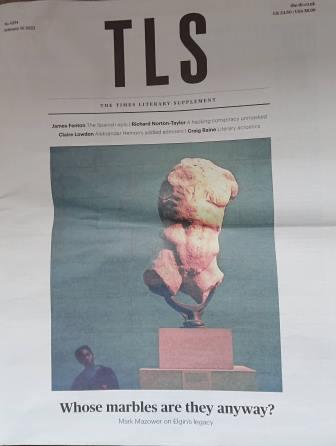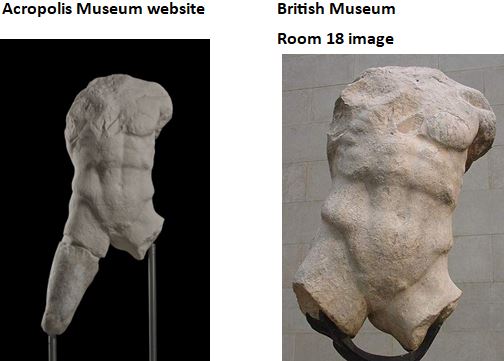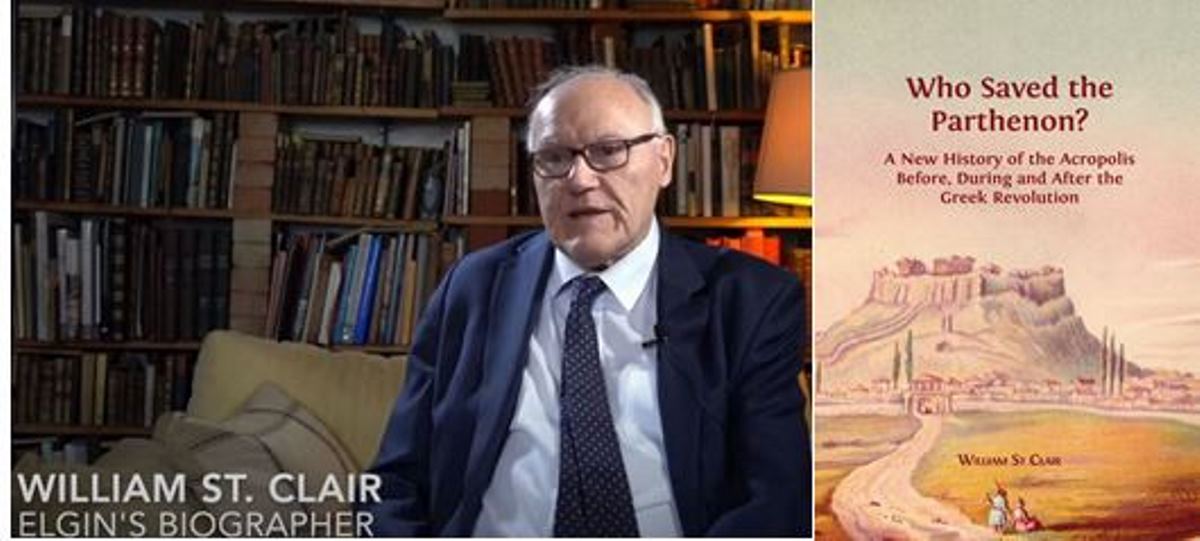The Times Literary Supplement (TLS) front page has the image of a pedimental sculpture in the British Musem's Room 18, which is sometimes refered to as Hermes, and the title: Whose marbles are they anyway? Mark Mazower on Elgin's legacy.

The Aropolis Museum has this on its site in reference to the pedimental sculpture that is featured on the TLS cover: Fragment from a man’s thigh usually identified with Hermes, although some researchers believe he is Kekrops, Theseus or Ares. It is adjusted to the plaster cast of the original remaining sculpture kept in the British Museum in London. Hermes strides to the viewer’s right next to Athena's chariot. He looks back as he stretches his right hand to the front perhaps pulling the reins of the chariot horses driven by Nike. On his back falls his chlamys the edge of which probably was wrapped around his left arm.
The fragment must have broken off from the sculpture and fell on the ground during the removal of the statue from the pediment by Thomas Bruce, lord of Elgin, who was in Greece between 1801-1804 when the country was under Ottoman rule, and forcibly detached most of the sculptures of the pediment still in their original position. It was found later on the Acropolis.

The TLS article by Mark Mazower is entitled 'Give them back!' and reviews William St Clair's 876 page book: Who Saved the Parthenon? A new history of the Acropolis before, during and after the Greek Revolution.
Read Frank Mazower's TLS review of Wlliam's book here.
Reference to William's first book 'Lord Elgin and the Marbles' originally published in 1967, saw William edit and re-publish this over the years as he also investigated the cleaning of the Parthenon Marbles in 1938-9 at the request of Lord Duveen, the donor of the gallery that continues to house them. Mark Mazower writes: "It took St Clair over a decade to wrest the relevant documents from the grasp of the British Museum, and the explosive result was a third and entirely rewritten edition of his 1967 study that ended with the devastating judgement that " the British Museum's stewardship of the Elgin Marbles turns out to have been a cynical sham."
Fred Mazower goes on to praise Wiliam St Clair as a 'magnificent example of an independent scholar'.We'd agree with that as we also remember his input on the UCL debate.
William St Clair's last book is about who really saved the sculptures given the scale of destruction wrought during the Greek struggle for independence. St Clair explains that when the revolution broke out, the British Ambassador Lord Strangford, asked the grand vizier to issue an order to ensure the preservation of the ancient monuments in Athens. William suggestes that the Ottomans in the summer of 1826 saved the Parthenon because that would prove that they deserved to be treated as a European power and would bring them diplomatic leverage.
Mazower concludes: "William St Clair surely knew what he was doing when he wrote a book that bolsters the case for the marbles' restitution to Greece by attributing their survival to the Ottomans."

Also read Suzanne Marchand's review.